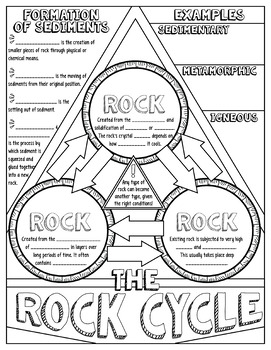
Weathering is the breaking down or wearing away of rocks where they are. The process is sometimes assisted by water. Physical weathering is caused by the effects of changing temperature on rocks, causing the rock to break apart. Chemical Process.Ĭhemical weathering is caused by rain water reacting with the mineral grains in rocks to form new minerals (clays) and soluble salts. These reactions occur particularly when the water is slightly acidic. Weathering is the process in which rock is broken down into smaller and smaller particles without any help of the transporting agents. The rocks get to break down into three types which are chemical, physical and biological agents. Rock cycles steps in order are as follows When the rocks get exposed to the extreme heat and pressure within the earth but it does not melt then the rocks get metamorphosed. Metamorphism changes the composition of the mineral and the texture of the rock.Īlso, Read: Properties of Stones | Requirements of Good Building Stones What Are the Steps of the Rock Cycle? This change in the rock occurs due to extreme heat and pressure. Metamorphism is the process of change of the minerals or geological texture of the rocks. This sediment which gets accumulated must become compacted and cemented together. Then during the process of sedimentation in the sediments are laid down new to form the sedimentary rock. The smaller pieces of fragments are known as sediment. These elements get transported from one place to another place by the running water, ice or gravity. Weathering of the rock on the surface of the earth into the smaller pieces. The process of cooling is slow in the crystals are produced of larger size. The rate of cooling will determine how much time the crystals will get to form.

If you see the buildings which are constructed in the olden days, then you will be observed that all the structures are constructed with the rocks. Rocks are widely used in the construction of building and highway. Rock is a natural rigid substance which is found on the earth. The rocks are composed of different types of mineral grains which is combined in different ways and possess various properties. Together, these thermo-hydro-mechanical stresses act in concert with glacial loading cycles to generate rock slope damage, preparing slopes for future failure.Rocks are one of the most common materials found on Earth. Changing cleft water pressures control effective stresses and the strength of rock mass discontinuities. Groundwater recharge by precipitation and snowmelt raises the water table seasonally, which is superposed on changes in hillslope groundwater tied to varying glacial ice elevations. In addition, high subglacial water pressures near the ice overburden level prevail at the base of temperate glaciers, and affect groundwater conditions in proximal valley flanks. Temperature changes generate thermal strain, inducing thermo-mechanical stresses capable of generating rock mass damage. Glacier retreat exposes rock walls to new thermal boundary conditions with strongly varying daily and seasonal cycles, a transition we term paraglacial thermal shock.

Bedrock beneath temperate glacier ice maintains near isothermal surface temperatures at ~0 ☌. Glacial cycles mechanically load and unload proximal rock slopes by the changing weight of ice, and in addition produce strongly varying thermal and hydraulic rock-surface boundary conditions tied to the fluctuating glacier (Fig.

Rock slope damage generated during glacial cycles is hypothesized to have a strong role in preparing rock slope failures, however, the mechanics of paraglacial rock slope damage remain poorly characterized. Glacial debuttressing is frequently implicated as a trigger for paraglacial rock slope failures, despite commonly observed large lag-times between deglaciation and the timing of failure and often without clear mechanical reasoning. Cycles of glaciation drive in-situ stress changes in underlying bedrock as glaciers advance, erode, and retreat, generating damage in adjacent rock slopes and influencing paraglacial slope stability.


 0 kommentar(er)
0 kommentar(er)
